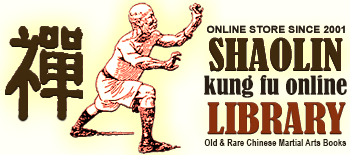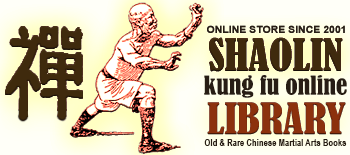
Short Historical Essay on Master Lam Sai Wing /Chapter 4/
WRITTEN BY HIS DISCIPLE ZHU YUZHAI. AS RELATED BY ZHANG SHIBIAO FROM PANGYU. THE TWELFTH YEAR KUIHAI OF THE PEOPLES REPUBLIC (1923), THE FIRST MONTH OF THE SUMMER.
Introduction - Master Lam Sai Wing Sets Up a School for Training the Fighting Arts in Canton - Master Lam Sai Wing Becomes a Disciple of Wong Fei Hung - Lam Sai Wing and Wong Fei Hung Talk to a Monk Called "The Iron Head" - Master Lam Sai Wing Gaines the Upper Hand over the Monk Called "The Iron Head" - Master Lam Sai Wing Deals with a Band of Rowdies - Master Lam Sai Wing and his disciples enter "The Society for Cooperation" with the aim of mutual confrontation to robbers and cutthroats - Master Lam Sai Wing is Lured into a Death Trap - Master Lam Sai Wing becomes the Chief Instructor in the army of Fujien province.
CHAPTER 4.
Lam Sai Wing and Wong Fei Hung Talk to a Monk Called "The Iron Head".

Monk Tie Tou said with a smile that learning the Kung Fu technique was extremely difficult for him, but one must be patient and persistent. If you train persistently, you will be able to achieve great success in full confidence. When he became a monk, he started to train himself by head butting. His teacher showed him some exercises with a stone mortar that used for butting and strengthening the head and the body. After long and persistent training he asked his mentor if his body could become as solid as iron. The mentor replied with a smile: "Why not? If you train systematically, all the time do exercises, your head will become like an iron bell!"
Afterwards he asked his mentor again: "Will the other people be able to get such results, if they do this exercise?" The mentor shook his head and said that there were no such people at that time. The monk "The Iron Head" achieved great results in training. While talking, he took a thick iron rod and stroke at his head with all his strength. The rod was visibly bent. That's why, if somebody wants to attack the monk, he can repeal the attack with his head. No doubt, it will have grave consequences for his enemy.
A well-trained monk can defend himself and attack with his head and the enemy can not resist him.

CANONICAL BOOKS BY LEGENDARY GRANDMASTER LAM SAI WING (1860 - 1943)

Lam Sai Wing. Taming the Tiger (工字伏虎拳)
The book scrutinizes an old canonical form (the Tao) of the Southern Shaolin Kung Fu, the Gung Gee Fook Fu.
According to the legend, the founder of the Hung Gar style, Hung Hei Goon studied this form under the tutorship of Southern Shaolin best fighter, a Master of the Tiger Style abbot Gee Sin Sim Si.
The Quintessence of Southern Shaolin Kung Fu - classical Fighting Methods from the book GUNG GEE FOOK FU KUEN:
"The claws of a Black Tiger"
"A fierce Tiger hiding in a cleft"
"The Bull strikes with its horn, makes a turn and breaches the sky"
"The arm of the Golden Dragon"
"To tear out a Phoenix's eye"
"The Tiger striking with its tail"
"The two Dragons steal pearls"
"The Snake raises up its head"
"The Celestial Dragon wags its tail"
"The Golden Dragon carries gifts in its claws"
"The hand that calls out a Ghost"
and others...

Lam Sai Wing. TIGER AND CRANE (虎鸖双形拳)
The book deals with the most popular and probably the most monumental form of the Hung Gar Kung Fu style. This form, known as The Tiger and the Crane, was created in the late XIX century by Lam Sai Wing's teacher, an unrivalled master of Kung Fu Wong Fei Hung. The Tiger's extremely tough, fierce and lightning-fast attack are balanced against and supplemented by the softer and smoother techniques of the Crane. The "tough" and the "soft" combine in a harmony.
The Quintessence of Southern Shaolin Hung Gar Kung Fu - classical Fighting Methods from the book Fu Hok Seung Ying Kuen:
"A Fierce Tiger Pressed Himself to the Ground"
"Tiger's Eye, Leopard's Blow"
"The Hungry Tiger Catches a Ram"
"The Tiger Goes Out from his Den"
"The Fierce Tiger Descends a Mountain"
"The Tiger Tramples On Wolves and Jackals"
"Claws of the Black Tiger"
"A Fierce Tiger Pushes the Mountain"
"The Dragon Hid, the Tiger Jumped Out"
"The Fierce Tiger Scratches Sand"
" Tiger's Roar and Crane's Call"
"A Crane Beak", "One Leg of a Flying Crane"
"A Hungry Crane Standing on One Leg"
"A Hungry Crane Catches Shrimps"
"Crane Crest", "The Monkey Steals a Peach"
"The Wild Goose Sits Down on the Sandbank"
"Prancing Unicorn", "Butterflies Depart in Flight"
"The White Horse Hoofs"
"Arhat Goes Out from the Cave"
"Eight Drunken Celestials"
and others...

Lam Sai Wing. Iron Thread (鐵綫拳)
The Iron Thread Form (Tid Sin Kuen) was created by Tid Kiu Sam (Iron Bridge III), one of the best martial artists in the history of China. His real name was Leung Kwan (1813-1886). He was one of the famous Ten Tigers of Guangdong. Tid Kiu Sam was born in the town of Nanghai, Guangdong province. He, the third child in the family, became a disciple of a monk from the Southern Shaolin Temple, Gwok Yan. Gwok Yan was one of the greatest masters of the Southern Shaolin Hung Gar Kuen school. He was known along the whole length of the Yangtse river. Through the years Tid Kiu Sam passed his knowledge down to one of his students, Lam Fook Sing. Some time later Lam Fook Sing taught Wong Fei Hung (1847-1924) and the latter Wong Fei Hung taught Lam Sai Wing (1860-1943).
The Iron Thread is considered as the highest form taught in the traditional Southern Shaolin Hung Gar Kung Fu system. This method belongs to a branch of "hard", or fighting Southern Shaolin Qi Gong (Chi Kung) and considered as "Internal Training". A master of the Iron Thread can withstand, with no consequences, the strongest of blows, including ones with heavy objects or cold steel, bend thick iron rods with his hands, and his "rooting power" is so strong that he cannot be displaced by a group of strong people. In addition, this wonderful method strengthens all internal organs, bones, muscles and sinews. The entire body thrives and rejuvenate.



